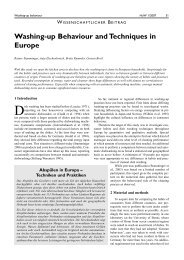Development of a novel mechatronic system for mechanical weed ...
Development of a novel mechatronic system for mechanical weed ...
Development of a novel mechatronic system for mechanical weed ...
You also want an ePaper? Increase the reach of your titles
YUMPU automatically turns print PDFs into web optimized ePapers that Google loves.
4 Materials and methods<br />
4.1 Detection <strong>of</strong> the single plant position<br />
Materials and methods<br />
Considering the expeditious research and development in the field <strong>of</strong> online<br />
detection <strong>of</strong> single plant position and plant/<strong>weed</strong> distinction, it is expected that<br />
appropriate <strong>system</strong>s will be available on the market in near future. Accordingly,<br />
the development <strong>of</strong> a <strong>system</strong> <strong>for</strong> single plant position detection was not targeted<br />
as the primary objective <strong>of</strong> this research. A simplified <strong>system</strong> based on the<br />
spectral characteristics <strong>of</strong> plants combined with the context in<strong>for</strong>mation <strong>of</strong> the<br />
planting pattern has been constructed as an interim solution.<br />
4.1.1 Sensor equipment<br />
4.1.1.1 Digital colour sensor<br />
After evaluation <strong>of</strong> several approaches <strong>for</strong> plant detection, concerning the basic<br />
requirement, which is accurate detection <strong>of</strong> the plant centre position in real time,<br />
a method based on non-selective detection <strong>of</strong> green-coloured objects, with an<br />
industrial RGB fibre optic sensor connected to an RGB digital fibre optic<br />
amplifier was chosen. The principle <strong>of</strong> colour detection in such sensors is based<br />
on a three-colour light source transmitter and appropriate receiver. The light<br />
emitter is located in the amplifier within which the beams <strong>of</strong> three colours are<br />
brought into a straight line by use <strong>of</strong> mirrors.<br />
The advantages <strong>of</strong> the three-colour light source sensors over conventional<br />
single-colour light source sensors are:<br />
� The received light quantity is converted into a ratio <strong>of</strong> three colours,<br />
and the target is recognized by its colour, whereas certain colours by<br />
single-colour illumination receive the same light quantity and they<br />
cannot be differentiated.<br />
� Even when the target position changes and the received light<br />
quantity changes, the ratio <strong>of</strong> the three colours does not change<br />
whereas by conventional <strong>system</strong>s the received light quantity changes<br />
according to the distance between the target and the sensor head.<br />
33





